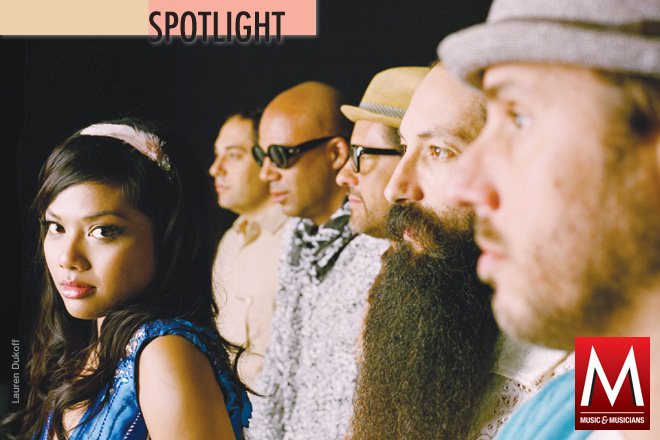DENGUE FEVER
Giving new life to a genre once thought lost to tragedy
When the brutal Khmer Rouge regime took control of Cambodia in 1975, it set about destroying all elements of Western culture. American-influenced music was banned, and singers like Sinn Sisamouth, Pan Ron and Ros Sereysothea were put to death along with more than a million of their countrymen. Cambodia’s distinctive brand of garage-style rock practically vanished. “So much of that music is lost forever,” says Dengue Fever bass player Senon Gaius Williams. “But their musical legacy lives on to inspire new generations of listeners.” Williams and his bandmates in Dengue Fever have spent the last decade trying their best to make certain that legacy remains alive and well.
Central to Dengue Fever’s take on so-called “Khmer rock” is captivating Cambodian songstress Chhom Nimol, who performed regularly before the king and queen of her native country before moving to the States in hopes of supporting her family through music. Williams, guitarist and vocalist Zac Holtzman, his keyboardist brother Ethan Holtzman, drummer Paul Smith and horn player David Ralicke discovered her singing in nightclubs in Long Beach, Calif.—home of the world’s second biggest Cambodian community outside of capital city Phnom Penh. In 2006, the group traveled to Cambodia and became the first to perform Khmer rock there since the fall of the Khmer Rouge in 1979.
Vocal trio the Living Sisters backs Nimol’s voice harmonically on Cannibal Courtship, and the self-produced disc further expands Dengue Fever’s steamy sax- and farfisa-driven sound with horns and keyboards. The album takes its title from its roiling opening track. “It’s about the idea of the female praying mantis turning around and eating the head of her lover after sex,” notes Williams. “But it’s also the idea of two cultures feeding off each other and creating something new.”
Perhaps the closing cut “Durian Dowry” best sums up Dengue Fever. “The durian is a fruit that’s considered precious in Cambodia,” says Williams. “The conga drum in it is straight out of Haitian voodoo ritual—good voodoo, not bad voodoo! So we have this cool Cambodian singer, a bluesy rock riff and a Haitian rhythm supporting it—and it’s wonderful how well it all mixes together.”
–Jim Bessman




comment closed